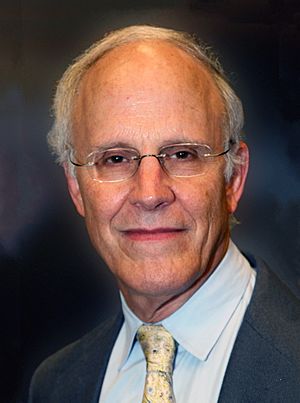David Gross facts for kids
Quick facts for kids
David Gross
|
|
|---|---|

Gross in 2007
|
|
| Born |
David Jonathan Gross
February 19, 1941 Washington, D.C., U.S.
|
| Education | Hebrew University of Jerusalem (BSc, MSc) University of California, Berkeley (PhD) |
| Known for | Asymptotic freedom Het... string Gross–Neveu model |
| Spouse(s) | Shulamith Toaff Gross (divorced) Jacquelyn Savani |
| Children | 2 |
| Awards | Dirac Medal (1988) Harvey Prize (2000) Nobel Prize in Physics (2004) |
| Scientific career | |
| Fields | Theoretical physics |
| Institutions | University of California, Santa Barbara Harvard University Princeton University |
| Thesis | Investigation of the many-body, multichannel partial-wave scattering amplitude (1966) |
| Doctoral advisor | Geoffrey Chew |
| Doctoral students | Natan Andrei Frank Wilczek Edward Witten William E. Caswell Eric D'Hoker Rajesh Gopakumar Nikita Nekrasov Stephen Bernard Libby |
| Signature | |
 |
|
David Jonathan Gross (born February 19, 1941) is an American theoretical physicist. He studies the smallest particles in the universe. He is also a string theorist, which means he explores ideas about tiny vibrating strings that might make up everything.
In 2004, David Gross won the Nobel Prize in Physics. He shared this award with Frank Wilczek and David Politzer. They won for discovering something called asymptotic freedom. This discovery helps us understand how tiny particles inside atoms behave.
Today, Gross is a professor at the Kavli Institute for Theoretical Physics (KITP). This institute is part of the University of California, Santa Barbara (UCSB).
Contents
Early Life and Education
David Gross was born in Washington, D.C., in February 1941. His parents were Nora (Faine) and Bertram Myron Gross.
He earned his first degree from the Hebrew University of Jerusalem in Israel in 1962. Later, he received his Ph.D. in physics from the University of California, Berkeley in 1966. His doctoral advisor was Geoffrey Chew.
Discoveries in Physics
In 1973, David Gross made a very important discovery. He was working with his student, Frank Wilczek, at Princeton University. They discovered asymptotic freedom. This idea explains how the strong nuclear force works. The strong nuclear force holds the tiny parts of an atom's nucleus together.
Understanding Asymptotic Freedom
Imagine you have two magnets. If they are far apart, their force is weak. But if you push them very close, the force becomes strong. Asymptotic freedom is a bit like that, but in reverse for tiny particles called quarks.
Quarks are the building blocks of protons and neutrons inside an atom's nucleus. The strong nuclear force acts between them. Gross and Wilczek found that when quarks are very close together, the strong force between them becomes very weak. They act almost like free particles.
However, if you try to pull quarks apart, the force between them gets stronger and stronger. This is why you can never find a single, isolated quark. They are always stuck together inside larger particles.
Quantum Chromodynamics (QCD)
The discovery of asymptotic freedom led Gross and Wilczek to create a theory called quantum chromodynamics (QCD). This theory describes the strong nuclear force. QCD helped complete the Standard Model of particle physics. The Standard Model explains the three basic forces:
- The electromagnetic force (like electricity and magnetism)
- The weak force (involved in some types of radioactivity)
- The strong force (which holds atomic nuclei together)
For this groundbreaking work, David Gross, along with David Politzer and Frank Wilczek, received the 2004 Nobel Prize in Physics.
Activism and Public Service
Besides his scientific work, David Gross has also been involved in important public discussions.
In 2003, he was one of 22 Nobel Prize winners who signed the Humanist Manifesto. This document shares ideas about human values and ethics.
In 2008, Gross was one of 20 American Nobel laureates in Physics who wrote a letter to the President. They asked for more funding for basic science research. They wanted more support for groups like the Department of Energy's Office of Science and the National Science Foundation.
In 2015, Gross signed the Mainau Declaration 2015 on Climate Change. This declaration was signed by 76 Nobel laureates. It urged world leaders to take action on climate change. It was presented at the COP21 climate summit in Paris.
Family Life
David Gross has been married twice. His first wife was Shulamith Toaff, and they had two children together. He later married Jacquelyn Savani, and he has a stepdaughter with her. He also has three brothers: Larry Gross, Samuel R. Gross, and Theodore (Teddy) Gross.
Honors and Awards
David Gross has received many awards for his important contributions to physics:
- J. J. Sakurai Prize, American Physical Society (1986)
- Fellowship Prize, MacArthur Foundation (1987)
- Dirac Medal, International Center for Theoretical Physics (1988)
- Oscar Klein Medal, Royal Swedish Academy (2000)
- Harvey Prize, Technion-Israel Institute of Technology (2000)
- High Energy and Particle Physics Prize, European Physical Society (2003)
- Grande Médaille d'Or, French Academy of Sciences (2004)
- Nobel Prize in Physics (2004)
- Golden Plate Award, Academy of Achievement (2005)
Memberships in Scientific Groups
David Gross is a member of many important scientific organizations. These include:
- Fellow, American Physical Society (elected 1974)
- Member, American Academy of Arts and Sciences (elected 1985)
- Member, National Academy of Sciences (elected 1986)
- Fellow, American Association for the Advancement of Science (elected 1987)
- Foreign Member, Chinese Academy of Sciences (elected 2011)
- Foreign Member, Russian Academy of Sciences (elected 2016)
See also
 In Spanish: David Gross para niños
In Spanish: David Gross para niños
- List of Jewish Nobel laureates

